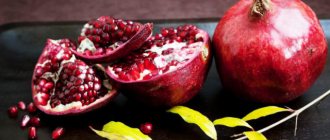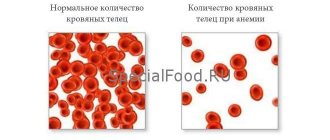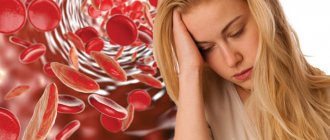According to the World Health Organization (WHO), in recent years there has been a trend towards a decrease in hemoglobin levels in the average person on the planet.
Although the value of hemoglobin level is influenced by many factors, including individual factors, in general, a low level indicates certain health problems.
Among the reasons causing a decrease in hemoglobin levels, in addition to a number of specific diseases, an important place is occupied by a lack of nutrients caused by an unbalanced diet.
There are certain foods that need to be consumed to increase the level of hemoglobin in the blood. First of all, attention should be paid to pomegranate, which we will talk about in this article. According to research , pomegranate actually has the property of raising hemoglobin levels.
Effect on the circulatory system
Pomegranate, as well as pomegranate juice, has a beneficial effect on the level of hemoglobin in the blood. This is due to the content of a huge amount of useful substances, including anthocyanins.
The effect of the beneficial substances contained in pomegranate promotes the production of blood and its saturation with oxygen. This is how the process of hematopoiesis occurs, the level of hemoglobin in the blood increases. By and large, it doesn’t matter whether we are talking about the fruit itself or pomegranate juice.
In addition to anthocyanins, other beneficial substances contained in pomegranate are also important. These include the following:
- cellulose;
- proteins;
- fats;
- amino acids;
- minerals - calcium, magnesium, iron, selenium, phosphorus, potassium, etc.;
- vitamins - groups of vitamins A, B, C, E, PP.
Due to the high concentration of nutrients and the high degree of their absorption by the body, pomegranate improves the functioning of the cardiovascular system and the quality of blood in general. This is expressed in the following beneficial changes noted when starting the systematic consumption of pomegranate:
- blood rejuvenation;
- improving tone and strengthening blood vessels;
- decreased blood pressure;
- counteracting the development of angina pectoris;
- blood thinning;
- improved blood flow;
- preventing the development of atherosclerosis;
- improving blood circulation in the brain.
Low hemoglobin: treatment at home
According to WebMD statistics, anemia, even in developed countries where there is no shortage of food and good environmental conditions, occurs in 6% of people. This condition is caused by a decrease in hemoglobin.
Hemoglobin is a complex protein compound. It has a structure that holds the smallest particles of carbon dioxide, and most importantly, oxygen. This biochemical process is the basis of the body’s life.
The hemoglobin norm for healthy people varies depending on gender and age:
- 120–140 g/l - for women;
- from 120 g/l - for children;
- 130–170 g/l - for men.
At one of the appointments, a 30-year-old woman who had recently suffered from bilateral pneumonia complained to me that she still felt weak, tired quickly, and felt emotionally depressed.
During an external examination, I found that the woman’s skin was pale and her palms were sweaty. The results of the CBC showed that moderate anemia was developing - hemoglobin dropped to 85 g/l.
Blood vessels: Human body. Medical encyclopedia. - M.: DeAgostini, 2016.
The development of anemic syndrome in those who have had community-acquired pneumonia is a common occurrence, as my colleagues A. Budnevsky, I. Esaulenko and others say. That is why it is important to regularly visit the doctor and monitor their health.
How to treat low hemoglobin in this case? The woman asked how to quickly increase hemoglobin without chemical iron-containing drugs and get vitamins naturally. The patient was recommended a special diet, rest and walks. After two weeks, the patient’s condition stabilized, hemoglobin approached 115 g/l.
Thus, if a blood test shows low hemoglobin, doctors may prescribe medication. But this is not always resorted to, because sometimes it is enough to treat anemia with folk remedies.
Other useful properties
Pomegranate also has other positive properties, expressed in a general strengthening effect for the body, supporting and restoring the nervous, lymphatic and genitourinary systems, giving the body energy and increasing vitality.
The secret of longevity of the inhabitants of the Caucasus and Transcaucasia is associated with the daily consumption of pomegranate.
See the photo for more details:
How much should you eat?
How much pomegranate should you eat daily? There are no special instructions on how to take the fruit specifically and exclusively to raise low hemoglobin levels in the blood. Everything is good in moderation.
To maintain hemoglobin levels at an acceptable level for health, you need to eat 1 fruit per day or consume 250 ml of natural juice .
If there is a significant lack of vitamins or an urgent need for regeneration of the body, you can slightly increase the level of consumption to 1.5 - 2 fruits per day or 400 ml of juice. But it is important to remember that even 50 ml of natural pomegranate juice daily leads to strengthening and rejuvenation of the body.
Eating pomegranate to increase hemoglobin
Recipes for iron absorption in the treatment of iron deficiency anemia:
- For young women and men whose disease is caused by temporary health problems. In the morning they eat half the fruit with seeds, and in the evening 10 walnut kernels.
- Universal method. Mix 20 g of freshly squeezed pomegranate juice, 0.5 tsp. lemon, 2.5 tbsp. l. warm water, sweeten with honey. Drink during the day.
- With a healthy stomach, after taking antibiotics. Mix lemon and pomegranate juices in a 1:1 ratio. Dilute with water 1:3, sweeten with honey. Take 2-4 tbsp per day. l.
How to drink pomegranate juice correctly?
Pomegranate juice is one of the 7 most beneficial juices for blood vessels and the heart. Freshly squeezed or bottled juice is suitable, but it must be directly pressed and not made from concentrate. With systematic consumption, the hemoglobin level will gradually increase.
To avoid the negative effects of consuming pomegranate juice on the teeth, digestive system and gastrointestinal tract, it is important not to systematically exceed the recommended amount of consumption.
In addition, experts say that the most suitable time for taking pomegranate in a course is autumn and spring, during periods of weakened immunity . This is due to the positive effect of pomegranate on the immune system.
Harm of pomegranate
Contraindications to the use of the healthy fruit and the drink prepared from it are:
- increased acidity of gastric juice;
- chronic diseases of the gastrointestinal tract in the acute stage - peptic ulcer, cholecystitis, gastritis, pancreatitis, erosive damage to the mucosa;
- tendency to constipation;
- partial intestinal obstruction and diverticulosis;
- acute inflammatory processes of the kidneys;
- urolithiasis and cholelithiasis.
The recommended dosage is reduced with increased blood viscosity. Contraindications are not absolute; if the condition is satisfactory, you can eat a handful of grains or drink a few sips of juice.
You should not give the crusts to children - they contain alkaloids, which can cause intoxication. Like all red fruits, pomegranates have an increased allergenic hazard. When first “acquainting” with taste, it is necessary to take into account the possibility of developing individual intolerance.
10 more foods to include in your diet
To achieve the best result, in addition to pomegranate, you should include in your diet other food groups that help normalize the functioning of the cardiovascular, immune, endocrine and reproductive systems, namely:
- fish - wild fish grown without direct human intervention are the healthiest, first of all you should pay attention to salmon, sturgeon, cod, pollock, whitefish, nelma, muksun, omul, etc.;
- nuts - walnuts, hazelnuts, hazelnuts, cashews, pistachios, Brazilian;
- porridge - rice, millet, buckwheat, oatmeal, rolled oats, etc.;
- dairy products - adults are better off with low-lactose dairy products;
- oils - olive, linseed, sesame, etc.;
- other fruits, citrus fruits, berries and vegetables (apple, lemon, beets, pumpkin, grapes, watermelon, peaches, etc.);
- green tea - in small portions, without sugar;
- cognac - rarely and in limited quantities;
- dry red wine - experts recommend limiting yourself to one glass per day and two on the occasion of a feast;
- natural coffee - in small quantities.
In addition, the absence of bad habits, especially smoking, stress, regular exercise and fresh air, is very important for heart health and blood composition.
How to raise hemoglobin with folk remedies
If there are contraindications for taking iron-containing pharmaceuticals, then how to increase hemoglobin in an adult? Let's consider the most effective treatment options:
How to quickly increase hemoglobin: juices from fruits and vegetables
At an appointment at a family planning center when examining a pregnant woman at 17 weeks, I noticed the patient’s unnatural pallor and lethargy.
The expectant mother complained that lately she has often been sleepy, she feels tired, she feels stuffy all the time, and she has already lost consciousness three times. Blood pressure is below normal - 90/60, pulse is weak.
After the results of a general blood test came back, it turned out that hemoglobin had decreased (89 g/l). This means that the woman developed moderate anemia.
The benefits of juices: Romanova O. Healing juices. 100 recipes. - M.: Vector, 2009.
A similar condition at 16–22 weeks of pregnancy is a particularly common occurrence, because during this period the fetal circulatory system is connected to the mother’s body. By this time, the pregnant woman’s natural iron reserves have been depleted.
In this case, a regular review of nutrition is not enough. How to increase hemoglobin? It is undesirable to use medications, so folk remedies for increasing hemoglobin - fruit and vegetable juices - will come to the rescue.
How to quickly raise hemoglobin with juices and herbs? For low hemoglobin, I recommend the following recipes:
- carrot and pomegranate juice (100 ml each);
- carrot-beet juice (100 ml, mix ingredients in equal proportions);
- beetroot-apple juice with cranberry juice (50 ml of each ingredient);
- lemon-apple juice with the addition of carrot-beetroot mixture (50 ml each).
To enhance the effect of carrot-beet juice, add celery juice or 1 tbsp. l. grated fennel root.
Carry out juice therapy for seven days. Take your drinks half an hour before breakfast. At the same time, remember that the benefits of vegetables and fruits are individual for everyone. Therefore, before you start drinking juices from them, visit your doctor who will give professional recommendations.
How to increase hemoglobin: smoothies
Pregnant women know the dangers of anemia (preeclampsia, threat of miscarriage, oxygen starvation of the fetus, which causes impaired brain activity). Therefore, they often ask how to increase hemoglobin quickly. I recommend (if there is no individual intolerance) to start the morning with an iron-containing smoothie as a breakfast component.
We raise hemoglobin with tasty and nutritious drinks prepared according to the following recipes:
- Mix beetroot and carrot juice (125 ml each) with 150 g of fresh, peeled and pureed kiwi and 150 g of chopped spinach, add 1 tsp. honey
- Puree the orange and peach (2 pieces each) and dilute with 250 ml of a mixture of the juices of these fruits, as well as 125 ml of grape juice.
- Grind strawberries and dates (6 pcs.), red algae (1 tbsp.) in a blender and add 125 ml of grapefruit juice.
- Grind cherries and green grapes (100 g each) in a blender with the kernel of one walnut.
- Puree a handful of blueberries and green grapes.
- In equal portions, mix and blend blackberries, raspberries, strawberries and kiwi. Add a little honey if necessary.
If you don’t know how to increase hemoglobin in a picky child, then sweet and delicious smoothies like these will be a godsend. The only limitation is to give them to children no more than 2 times a day and add only those ingredients that do not cause an allergic reaction. If you notice any unwanted symptoms, be sure to contact a medical facility.










